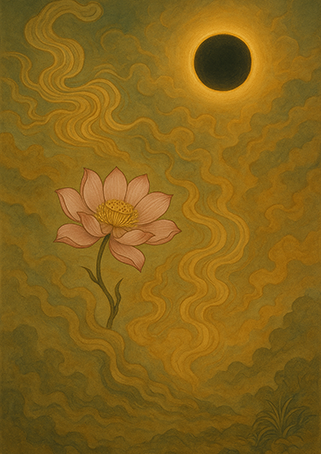Xieyi・The Rootless Tree:24 Chapters-Chapter 19#293

The poems of “The Rootless Tree” express a fundamental force rooted in harmony with heaven and earth, the cyclical flow of yin and yang, and the infinite potential of existence。
This painting is an expressive Xieyi in the tradition of “futu” (spiritual diagrams), passed down for generations in Wudang Mountain, China. It is drawn through a technique where energy flow (xingqi) channels the internal intention into visual form。 In the Taoist world, there exist spiritual and symbolic images called “futu”。
In the Taoist world, there exist spiritual and symbolic images called “futu”。
These are a type of talisman—not merely religious items, but expressive spiritual paintings that act directly on the mind of the viewer。
Since ancient times, many people have placed these Taoist-style “Xieyi” and futu in their homes, studies, or bedrooms, wishing for longevity, health, auspiciousness, and family harmony. Viewing such paintings was not just aesthetic appreciation, but an act of inviting the presence of the Dao into one’s life and tuning the body and mind。
Thus, “Xieyi” is more than artistic expression—it is a medium that bridges the spirit, life, and harmony with the universe。
This kind of artwork is not meant to be seen only with the eyes, but felt with the heart。
It communicates with the Dao, resonates with the qi of nature, and quietly stirs the viewer’s inner self。
Futu and “Xieyi” continue to live on from ancient times to this day as “sacred images that speak to the soul.”
Below, we present the original text of the philosophical poem “The Rootless Tree,” along with a modern Japanese translation and interpretation。
※ The author of “The Rootless Tree,” Zhang Sanfeng (1247–?), is also renowned as the founder of Tai Chi, and it is said that he applied the essence of this work to Tai Chi. As an additional note, we include an interpretation connecting this to the Tai Chi tradition of Wudang Mountain.
The Rootless Tree・Chapter 19

▶Original Text
無根樹,花正雙,龍虎登壇戰一場。鉛投汞,配陰陽,法象玄珠無價償。此是家園眞種子,返老還童夀命長。上天堂,極樂方,免得輪迴見𨶒王。
▶Modern Translation
The flower on the rootless tree blooms doubly.
The dragon and tiger ascend the altar and clash in sacred combat.
Throw lead into mercury, harmonize yin and yang.
The Mystic Pearl, worthless to fools, is beyond price.
This seed within the household reverses age and returns one to childhood,
Ascending to paradise, escaping the wheel of rebirth, never again facing the lords of death.
▶Interpretation
This poem portrays the climax of alchemical practice.
The internal dragon and tiger converge to produce the Mystic Pearl—a symbol of enlightenment and eternal life.
Escaping reincarnation, the practitioner attains immortality.
▶Interpretation related to Tai Chi
Advanced Tai Chi manifests harmony of yin and yang, awakening inner potential.
The Mystic Pearl represents integration of body, breath, and spirit.
The goal: freedom from suffering, eternal peace.
Copyright © MASAKI WAKABAYASHI. All rights reserved.




